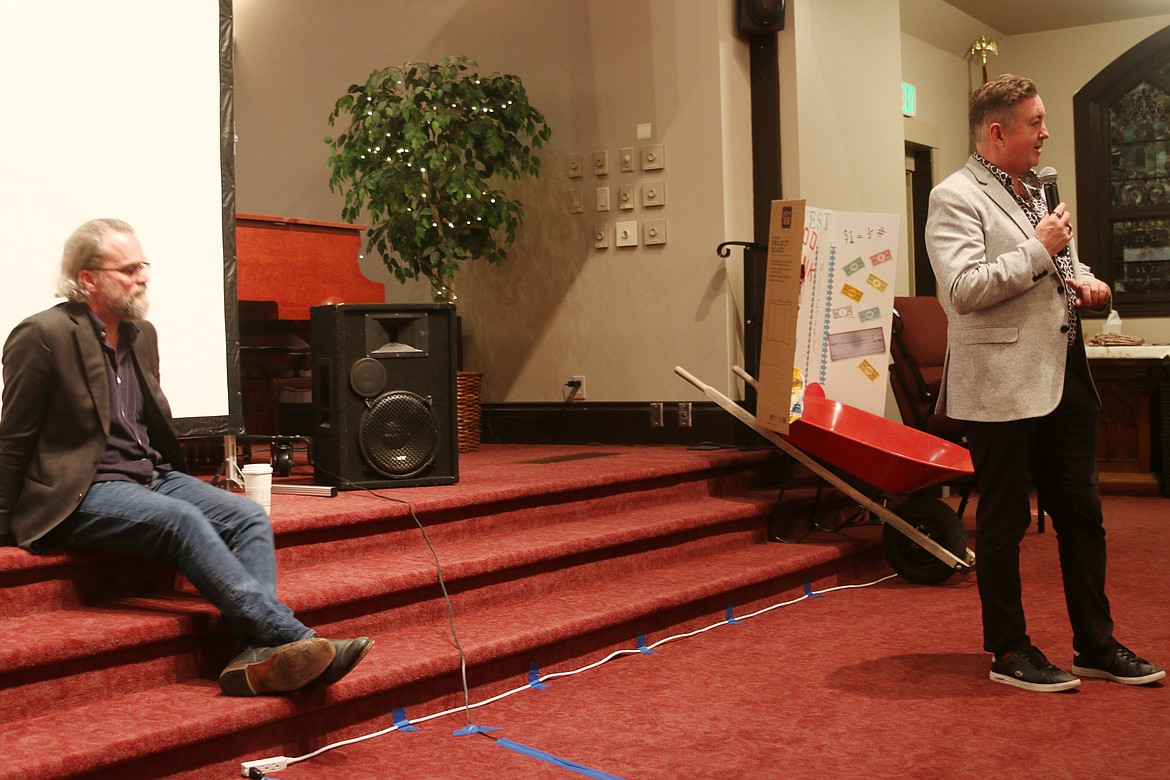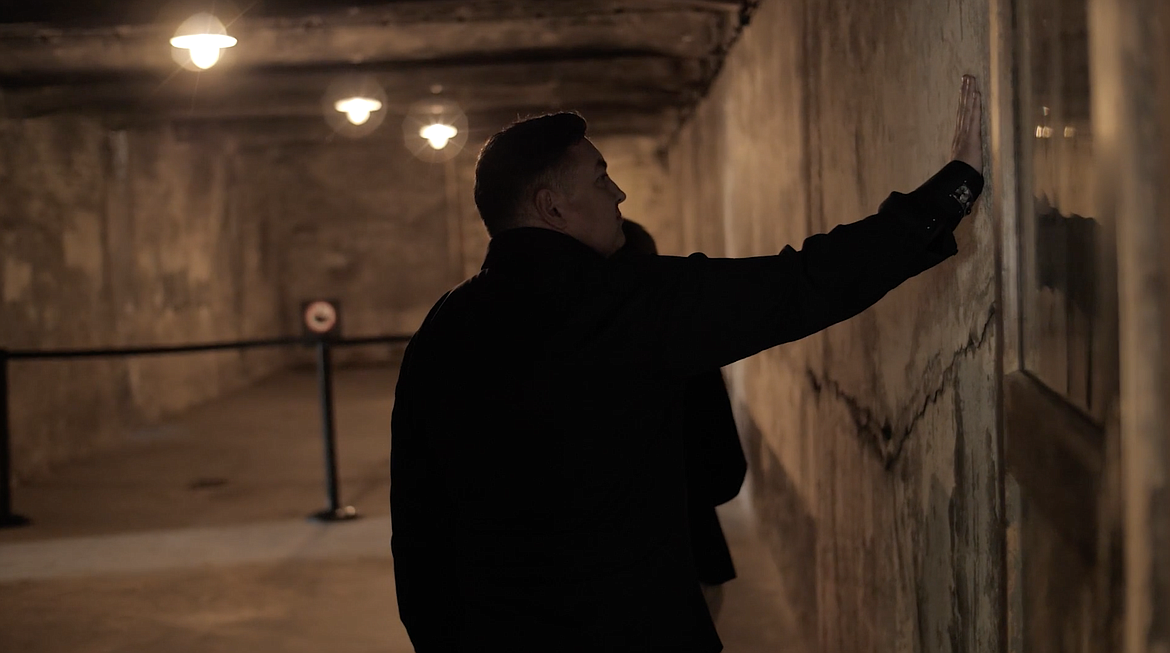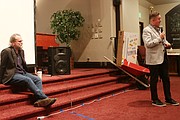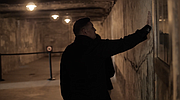Compassion: 'The Cure for Hate'
SANDPOINT — It was the face of his newborn daughter, scrunched together, staring up at him in the delivery room, the first thing she saw.
That was the catalyst.
However, his journey away from extremist ideology and hate groups such as the Aryan Nations evolved over time, Tony McAleer told a crowd of roughly 100 area residents who attended Sunday's screening of "The Cure for Hate."
For 15 years, McAleer was a hardened neo-Nazi, a leader in the White Aryan Resistance. In the 1980s, he was active in everything from anti-immigrant activity to Holocaust denial to street violence. In the 1990s, publicity stunts and his operation of a white supremacist phone line brought him increasing notoriety. He attended the Aryan Nations in Hayden Lake, looking up to Richard Butler as a father figure and a role model.
Inspired by others, he weaponized the internet as a tool for recruitment and propaganda for a whites-only nation. It would lead to his arrest for violation of the Canadian Human Rights Act of 1994.
"I was cut off from my heart. I was operating solely from my mind and from my ego," McAleer told the crowd. "And from that place of non-feeling, from that place of disconnection, I truly believe the level to which we dehumanize other human beings is a mirror reflection of our own internal disconnection and dehumanization."
It took that first look at his daughter to begin the process of change.
"It's hard enough to get someone to admit who they are or to change who they are," he said. "It was my children who helped change my heart. The heart has no defense."
When he left the movement behind, McAleer said it was still — at least at first — was the bedrock of his identity. It was what he read, the movies he watched and the music he listened to; it was the friends he hung out with.
He'd begun the journey of self-discovery. He'd created a new life as a financial analyst and was finding success. He was attending seminars and reading, working to be a better version of himself.
It would be a birthday gift of a therapy session that would take that process further.
He'd grown up the son of a psychologist in a middle-class neighborhood. He idolized his father despite the emotional distance of their relationship. His discovery of his father's affair when he was 11 left him angry, rebellious, and disconnected. One of the three high schools he attended in a three-year period attempted to beat him into better grades, McAleer said.
Instead, he felt helpless and worthless. It was at that last high school that McAleer said he met a group of skinheads. They offered him both acceptance and an identity. He willingly followed their path in exchange for both.
"Often we feel that compassion is passive; it's soft, it's weak, and can be taken advantage of," he said. "When you marry it with healthy boundaries and consequences, it's truly a powerful, powerful thing."
He told of sitting in the therapist's office, staring at first one spot in the carpet and then another. The therapist asked why he wasn't speaking when he clearly had something on his mind.
Finally, McAleer said he took a chance. He spilled everything about his background: his father, his involvement with hate groups, everything.
The therapist's smile grew bigger and bigger. It pissed him off, McAleer said. What he asked the therapist was so funny.
"You do know I was born Jewish, right?" McAleer recounted the man's response.
He sat back in the chair, his cheeks flushed with shame.
"Here's this man who loves me, who wants to heal me, who wants to heal my family," he said. "And here I am sitting in shame, knowing that I once advocated for the annihilation of him and his people."
But then the man looked at him, and McAleer said he would never forget what he told him.
"That's what you did," the therapist told him. "But that's not who you are. I see you. I see little only. And that's when I started sobbing and crying."
He began "running toward the pain" instead of avoiding it. He worked to heal the wounds left by his childhood. His therapist listened, helped him address the pain head-on, and held him accountable for his actions.
"You're going to have to go public with your story," he recounted being told. "You can't just waltz into the distance and keep it quiet. Not on my watch."
It would take years of soul-searching and therapy to understand why he had been attracted to white supremacy and to gain the tools to leave and to help others take those same steps.
He would go on to help found Life After Hate, a group dedicated to helping those wanting to leave hate groups, in 2011. He worked with law enforcement and spoke before the U.S. House Subcommittee on Civil Rights and Civil Liberties on how to confront the problem of white supremacy.
After being gifted compassion, first from his children and then from others like his therapist, McAleer knew he needed to go further. He needed to go to Auschwitz to bear witness to the horrors of the impact of hatred and extremism. He told those gathered that he felt he needed to atone for the hatred he'd once espoused and spread. It would be a way, he thought, to deepen his commitment to the work against racism and white nationalism.
The Jewish tradition calls it "t'shuvah" — described as a return to God and people that is made possible through repentance.
He would connect at some point with filmmaker Peter Hutchison, who had wanted to tell the story of "formers," a phrase that those who have left white supremacy behind use to describe themselves.
The two would film McAleer's journey and his effort to explore the conditions that led to fascism's rise in the 1930s. His goal was to shed light on how people get into and leave violent extremist groups.
The result? "The Cure for Hate: Bearing Witness to Auschwitz".
McAleer and Hutchison said they wanted to create a film to both tell McAleer's story, and reach those struggling with their identity, to help them not make the same mistakes. The film — and the tour that took them to Sandpoint — are part of that effort to reach those vulnerable to recruitment and indoctrination by violent extremists and hate groups.
"The film is not just Holocaust education," Hutchison said. "It's a broader exploration of where it comes from; how do we reach other people?"
Saying he wanted to be an optimist, to believe that things are getting better, audience member Eric Ridgway asked how society can move forward when extremism still exists in the U.S., Europe, and throughout the world.
"After the Holocaust, we said never again. What do we do as a species?" Ridgway asked. "I mean, it's still going on."
There are two parts to that, McAleer said, and part of why the pair teamed up on "The Cure for Hate."
One was for education, he said, pointing to studies that show 66% of millennials can't say what Auschwitz was.
"As the last of the survivors pass from this earth, they'll no longer exit in living memory," McAleer said. "If we let that memory slide, if we do not remember, then we are doomed to repeat it."
The second half of the equation is to be a part of the solution, to push ourselves outside our comfort zones and follow the "three Cs" — courage, compassion and curiosity.
"We cannot be passive observers in this great play that is our lives," McAleer said. "Yes, there's things happening in Sweden. Yes, there's things happening in Italy. Yes, there's things starting to happen again in Germany. But we can't just sit there passively, being observers to that. … It starts with us. It's the tug of war between good and evil, right? What did Edmund Burke say, that for evil to thrive, good men and women do nothing."
That means, McAleer said, offering compassion to extremists instead of meeting them with opposing ideologies, being courageous to work to make a difference, and being curious about others.
"If everybody lived their lives from those three places, the world will start to be a different place," he said. "We all have the ability to inspire people. In fact, we all inspire people, whether we want to or not, whether we're conscious of it or not.
If you're angry and short with people, you're teaching the people around you to be angry and short with the people they're around. However, if you're kind and compassionate with people, it gives them both permission — and an example — of how to be kind and compassionate to others.
"It's who we choose to be in every moment of every day that affects the people around us, that inspires the people around us," McAleer said. "We have to be courageous with that compassion. We're not going to solve the problems of society from inside our comfort zones. Isn't going to happen.
That means courage. That means compassion. That means being curious.
"You might think the problem is too big, that it's all over the planet," McAleer said. "But that's what you can do. It is being a part of the millions of tiny acts that may seem insignificant but that are going to make the changes."
Information: thecureforhatefilm.com and lifeafterhate.org







